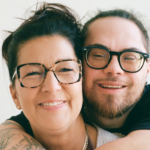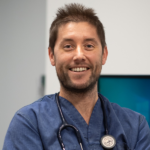Orderlies: pouring their hearts into caring for cardiovascular patients
Interview with Anick Lamontagne, orderly at the Montreal Heart Institute
Home > Blog > Orderlies: pouring their hearts into caring for cardiovascular patients
This article is adapted from the fourth edition of the Foundation’s magazine
Anick Lamontagne spent 17 years as an orderly in CHSLDs and CLSCs, and as an in-home attendant helping with end-of-life care. She never thought she’d end up working in a hospital setting. But after five years in the Montreal Heart Institute’s Critical Care Unit, she can’t see herself working anywhere else. “Once you’ve worked in cardiology, it’s hard to leave.”
Colleagues who go above and beyond
“Cardiology, especially critical care, is not for everyone. Codes (cardiac arrests) are called quite often. You can’t be scared, and you’ve got to be fully committed to the job. From the moment I joined the Institute, the team felt like a big family. The feeling of unity I’d experienced during my interview turned out to be real. In every unit I’ve worked in, I’ve always received helpful answers to my questions – it really feels like everyone wants me to have the tools I need to perform my duties. I’ve been learning since day one. And that’s true for every member of the healthcare team, from the physicians and the nursing staff to my orderly colleagues who’ve always been there for me: Mireille Potvin, Carl Dion, Richard Rondeau… I could go on and on,” said Anick.
Empathy as a path to healing
As with other healthcare professionals, empathy and dedication are among the strength of orderlies. These qualities play an essential role in their work in close proximity to patients, even if it sometimes takes places in the shadows.
“You’ve got to love what you do. Really. You need to know how to put yourself in the other person’s shoes. Even if you’re not the one whose chest has been opened, you need to understand what that would feel like. You need to be attentive and emotionally available. Does the patient want to talk about their anxiety? Would it be better to soothe them with a care routine in silence and offer an opening if anything changes? Sometimes, the comfort and serenity of silence is enough. And if we start to feel burned out, there’s always a colleague who’s ready to step up and help in difficult situations,” she said.
A little goes a long way
One of the responsibilities of an orderly is to help patients resume their activities of daily living (ADL). That might mean learning how to sit without any help or brushing their teeth. Every step is part of the recovery process.
“Take a patient who’s just been transferred from the intensive care unit and hasn’t washed their hair in a week… Our goal with this person is to help them regain a semblance of a normal life. For that patient, it’s not just about washing their hair – it’s the act of doing so that makes all the difference. Patients tell us how good it makes them feel, and they’ll often become emotional when doing so. We also monitor their progress. We work closely with the nursing team to determine what we can do according to the patient’s condition. Could we walk together in the hallway, or would it be better for them to stay immobilized? We’ll see them arrive in our unit in very serious condition and, often, we see them get better. When patients visit us after they’ve recovered, I like to remind them that I’d told them they’d be walking again. It’s very rewarding and motivating to encourage patients to regain their autonomy and to realize we’ve played a part in their recovery.”
Caring for a patient’s body while remaining attentive to their emotional well-being
“Changing a patient’s underwear, washing a them, or helping them into a new position is part of our daily tasks. But our work is also profoundly human-centric. Holding a hand or offering some comforting words at the right time can make an impact a person’s mindset. Nurses and medical staff don’t have enough time with patients to create those moments. The minute you set foot in a room you feel the patient’s energy. You need to know how to decipher it. Even if a patient is intubated and can’t communicate, I tell them what I’m doing. I establish contact with them. I want to comfort them and be attentive to their needs. In my unit, many patients are in vulnerable situations and that requires a continuously gentle approach. I give what I’d like to receive. It’s as simple as that,” she added.
A job that demands physical and mental strength
Because orderlies work very closely with patients, they’re never far when their condition deteriorates. “When a code blue is called, when you’re performing a cardiac massage and you meet the patient’s eyes, it’s a really emotional moment. I once performed three cardiac massages in one day. You never know what’s going to happen and you always need to be ready. In these extremely critical situations, team synergy takes on a whole new meaning. We communicate, we help each other, we work side by side to maximize the patient’s odds of survival. You need to have a strong heart,” she said.
Anick’s heart
If Anick’s heart could speak, here’s what it would say:
“I’m grateful when a patient takes a moment to look at me or take my hand; when a patient says my name and thanks me. It’s extremely gratifying! These moments are why I do this job.”
Would you like to support patient care? Make a donation now.
Donate









